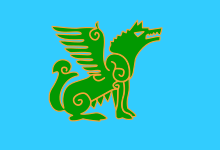
Back Нэгъойхэр ADY Nogais Afrikaans Nogais AN نوغاي Arabic نوجاى ARZ Нугъаял AV Noqaylar Azerbaijani نوقایلار AZB Нуғайҙар Bashkir Нагайцы Byelorussian
 | |
| Total population | |
|---|---|
| c. 270,000[3] | |
| Regions with significant populations | |
| 126,000[4] | |
| ∟ | 40,000[5] |
| ∟ | 22,569[5] |
| ∟ | 17,368[5] |
| ∟ | 9,990[5] |
| ∟ | 9,320-20,000[5] |
| ∟ | 3,740[5] |
| ∟ | 2,819[5] |
| 34,000-50,000 | |
| 5,000[6] | |
| 500[citation needed] | |
| 385-2,885[7] | |
| 90,000[8] | |
| Languages | |
| Nogai, Russian | |
| Religion | |
| Sunni Islam[3] | |
| Related ethnic groups | |
| Crimean Tatars, Bashkirs, Kazakhs, Karakalpaks, Kumyks, Volga Tatars[9][10] | |

The Nogais (/noʊˈɡaɪ/ noh-GY)[a] are a Kipchak[11] people who speak a Turkic language and live in Southeastern Europe, North Caucasus, Volga region, Central Asia and Turkey. Most are found in Northern Dagestan and Stavropol Krai, as well as in Karachay-Cherkessia, Chechnya and Astrakhan Oblast; some also live in Dobruja (Romania and Bulgaria), Turkey, Kazakhstan, Uzbekistan, Ukraine and a small Nogai diaspora is found in Jordan. They speak the Nogai language and are descendants of various Mongolic and Turkic tribes who formed the Nogai Horde. There are eight main groups of Nogais: the Ak Nogai, the Karagash, the Kuban-Nogai, the Kundraw-Nogai, the Qara-Nogai, the Utars, Bug-Nogai, and the Yurt-Nogai.
- ^ Minahan, James B. (2016). Encyclopedia of Stateless Nations: Ethnic and National Groups around the World (2nd ed.). Santa Barbara, CA: Greenwood/ABC-CLIO. p. 302. ISBN 978-1-61069-953-2.
- ^ Minahan, James (2000). One Europe, Many Nations: A Historical Dictionary of European National Groups. Greenwood Publishing Group. pp. 493–494. ISBN 978-0-313-30984-7.
- ^ a b Golden, P. B. (2022). "Nogai people". In K. Fleet; G. Krämer; D. Matringe; J. Nawas; D. J. Stewart (eds.). Encyclopaedia of Islam Three Online. Brill. doi:10.1163/1573-3912_ei3_COM_41065.
- ^ "Russian Census of 2021". (in Russian)
- ^ a b c d e f g Russian Census (2021)
- ^ İsmail, Nilgün. Romanian Tatar language communication in the multicultural space (Report).
- ^ "About number and composition population of Ukraine by data All-Ukrainian census of the population 2001". Ukraine Census 2001. State Statistics Committee of Ukraine. Archived from the original on December 17, 2011. Retrieved 17 January 2012.
- ^ "A Sociological Research on the Nogai Turks" (PDF).
- ^ Ахметзянов М. И. Татарские родословные (шеджере) / М. И. Ахметзянов – Казань: ИЯЛИ им. Г. Ибрагимова // Золотоордынское обозрение. 2015.
- ^ Исхаков Д. М. Юго-Восток Татарстана: проблема изучения этнической истории региона XTV-XVII вв. // Элмэт — Альметьевск. 2003.
- ^ Pankratov, Vasili; Litvinov, Sergei; Kassian, Alexei; Shulhin, Dzmitry; Tchebotarev, Lieve; Yunusbayev, Bayazit; Möls, Märt; Sahakyan, Hovhannes; Yepiskoposyan, Levon; Rootsi, Siiri; Metspalu, Ene; Golubenko, Maria; Ekomasova, Natalia; Akhatova, Farida; Khusnutdinova, Elza; Heyer, Evelyne; Endicott, Phillip; Derenko, Miroslava; Malyarchuk, Boris; Metspalu, Mait; Davydenko, Oleg; Villems, Richard; Kushniarevich, Alena (25 July 2016). "East Eurasian ancestry in the middle of Europe: genetic footprints of Steppe nomads in the genomes of Belarusian Lipka Tatars". Scientific Reports. 6 (1): 30197. doi:10.1038/srep30197. PMC 4958967. PMID 27453128.
Cite error: There are <ref group=lower-alpha> tags or {{efn}} templates on this page, but the references will not show without a {{reflist|group=lower-alpha}} template or {{notelist}} template (see the help page).